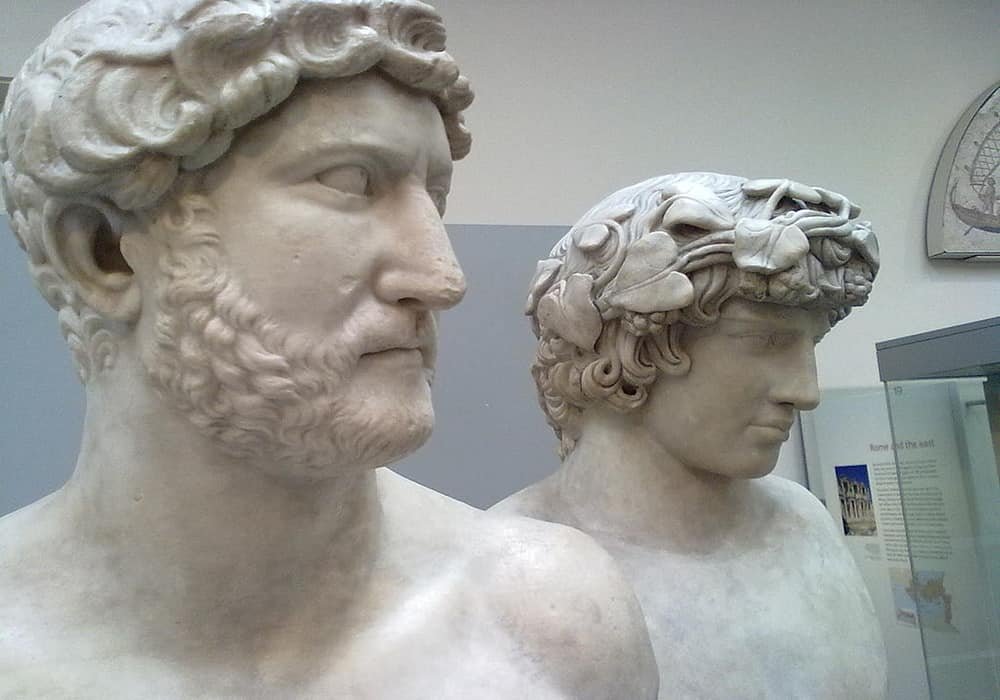Who Was The Roman Emperor Hadrian?
Hadrian was Roman emperor from the year 117 to 138. He was born into a Roman-Italian-Hispanic family who settled in Spain from the Italian town of Atri in Picenum. His father was a senator and was Emperor Trajan’s first cousin.
Short biography
Publius Aelius Hadrianus, better known as Hadrian, was Emperor of Rome from 117 to 138. He belonged to a Roman aristocratic family with Italian roots, Hispania. After his father’s death, he was raised by Emperor Trajan of Rome who was his father’s cousin. He began his administrative career as a minor judge and went on to three terms in the army to gain military experience.
Later, he was elected to the senate and became a member of the Emperor’s private entourage. He was close to Empress Plotina and married to his niece, which made him eligible to succeed Trajan after his death. Unlike his predecessors, he did not expand the Roman Empire, but consolidated his empire and brought peace and prosperity. He built monuments and developed art and culture.
Hadrian’s Wall, which protected his kingdom from barbarians and his autobiography, is noteworthy. He had no children of his own and was openly gay, so he had to adopt a successor. Although his reign was marred by controversy, he went down in history as one of Rome’s fine Emperors.
Born: January 24, 76 AD, Rome, Italy
Died: July 10, 138 AD, Baiae, Italy
Full name: Publius Aelius Traianus Hadrianus Augustus
Burial place: Castel Sant’Angelo, Rome, Italy
Government: 11 August 117 – 10 July 138
Partner: Vibia Sabina (r. 100 AD – 136 AD)
Family:
Spouse / Ex-: Vibia Sabina (M.100 AD – 136 AD)
Father: Publius Aelius Hadrianus Afer
Mother: Paulina
Brother: Paulina Minor
Died On: July 10, 138
Place of Death: Baiae
Founder / Co-Founder: Panhellenion
What was this emperor famous for?
Hadrian is best known for his major building projects throughout the Roman Empire and, especially, Hadrian’s Wall in northern England. He was considered one of the so-called Five Good Emperors, and his reign was marked by internal stability and military success.
Read also ? European Noble Ranks | What is the hierarchy of titles in Aristocracy?
How is his personality?
Hadrian was able to be generous, but also pettiness and cruelty. The dangerous rebellion of the Jews during his reign was sparked by an unwise attempt to Hellenize them. Her relationship with her predecessor, Trajan, is to some extent complex, and the circumstances of her access to power are shrouded in mystery.
Emperor Hadrian’s Childhood and Early Life
Hadrian was born on 24 January 76 in Italica, Hispania into the ‘Nervan-Antonine’ dynasty, which was an established Roman family with roots in Italy, Hispania, Baetica, near modern Seville, Spain. (According to some historians he was born in Rome).
His father, Publius Aelius Hadrianus Afer Trajan, was a cousin of Emperor Trajan and a senator of the ‘Praetorian’ rank who spent most of his time in Rome. His mother, Domitia Paulina, came from Hispano – a family of prominent Roman senators from Gades, Spain. Her older sister, Aelia Domitia Paulina, is her only sibling.
His parents died when he was 10 years old and he became the ward of Emperor Trajan and Publius Acilius Attianus who was Trajan’s ‘Praetorian Perfect’. Young Hadrian moved to Rome at the age of 14 where he was given an aristocratic education and taught a variety of subjects. He loved Greek literature and earned the nickname ‘Graeculus’.
Emperor Hadrian’s career
He began his career as a ‘Vigintivirate’, who was a minor judge in inheritance court. At the age of 19 he performed his first military service as a stand in the Roman army ‘Legio II Adiutrix’. He then transferred to the ‘Legio V Macedonica’. He has another military service spell in the ‘Legio XXII Primigenia’ stands, which gives him the distinction of having extraordinary military experience.
In 101, he was elected as “Quaestor”, which was the beginning of his career in the Senate. His first assignment was to read the Emperor’s speech. Later, he was made ‘ab actis senatus’ and given the responsibility of keeping records of Senate hearings.
Hadrian was a member of Trajan’s private entourage during the First Dacian War. After the war, he was elected a ‘praetor’ and given responsibility as a soldier. He was promoted to Deputy ‘Legion – Legion I Minervia’, equivalent to the rank of General, during the Second Dacian War.
After the war he was appointed governor of the province, Lower Pannonia, which was considered a high-ranking post for someone his age. Legend has it that during this period Trajan gave Hadrian a ring that was given to him by his predecessor, which was a signal of succession.
When Trajan was seriously ill and had to return to Rome. Hadrian remained in Syria to guard the Roman rear. As such, he became the de facto commander of the Byzantine army. Trajan dies at Selinus and Empress Plotina signs the succession document transferring power to Hadrian.
Emperor Hadrian’s Accession and Administration
Accession to the throne was not smooth for Hadrian as Trajan did not personally sign any documents to transfer power to him. He is relatively younger than other senators who also have ambitions to take the throne. However, he had the support of the army and his rivals were eliminated as he consolidated power in the East.
He did not follow expansionist policies as Emperor. He believed in the peace and consolidation of his empire. He ceded Mesopotamia in the East and built Britain’s famous Hadrian’s Wall to protect his territory.
He devoted much of his time and effort to reviving art and architecture in his kingdom. He built his villa with landscaped gardens and began renovating monuments that had been destroyed by war or natural disasters. He also personally wrote Latin and Greek poetry and an autobiography entitled ‘Phlegon of Tralles’.
One of the most distinctive aspects about Hadrian’s reign is that he spent a great deal of time traveling around his kingdom. Unlike most Emperors before him who left Rome only to conquer the land, he visited his people and worked to build peace and prosperity.
During his travels he was accompanied by an architect who gave him advice on building new buildings or renovating ruins. He also negotiated peace within his kingdom and with his neighbors. A striking example is the peaceful settlement with the Parthian king, Osroes, when he visited the Euphrates.
He toured Greece in 124-125 and participated in the religious rights ‘Eleusinian Mysteries’. He revised the Athenian constitution and began building many monuments.
During his reign from 117 to 138, Hadrian earned a reputation as a kind administrator and humanist. He brought legal reforms to define the law and did not leave it to the senator’s interpretation.
Hadrian wrote his poetry and biography entitled ‘Phlegon of Tralles’.
He built many monuments, including his villa and tomb. Hadrian’s Wall was one of the first of its kind of defensive structure.
Emperor Hadrian’s Personal Life & Heritage
He married Vibia Sabina who was the granddaughter of Emperor Trajan’s nephew by order of Empress Plotina, after the death of her husband. Plotina and Hadrian shared the same philosophical interests and got along well. However, Trajan is not so enthusiastic about a marriage that prioritizes comfort because Hadrian and Sabina do not get along well and do not have children of their own.
Hadrian was the first Roman Emperor to publicly announce he was gay. His partner, Antinous, accompanies him on all his travels and finds mention in his poetry. He even named the Greek city after him when he died prematurely from drowning.
Because he did not have children of his own, he adopted Aellius Caesar who unfortunately died so he again adopted Titus Aurelius Fulvus Boionius Arrius Antoninus who later became Emperor after Hadrian died on 10 July 138 AD at the age of 62.
Hadrian Named the City After His Boyfriend
His marriage to Sabina was unhappy, and there is no reliable evidence that he has ever expressed sexual attraction to women, in contrast to much of the preliminary credible evidence that he was sexually attracted to boys and young men.
The Roman emperor Hadrian is best remembered for building Hadrian’s Wall, marking the northern frontier of his empire. And although Hadrian got married around 100 AD, she also had a boyfriend. Hadrian’s colleague was a young Greek named Antinous. When his lover drowned, Hadrian founded a city in Egypt and named it Antinopolis in his honor.
The Romans didn’t care about men taking male lovers. What matters is only what role a man plays during sex: an older man always needs to take a dominant and active role.
Hadrian and Antinous: A History of Ancient Love
There is a Roman love story between Emperor Hadrian and his Greek sex servant, Antinous, which is so fantastic, almost impossible to believe. This is a tragic tale of love, scandal, sacrifice, and extraordinary mystery. The scandal wasn’t really about two men having sex; it’s about two men who have very real feelings for each other.
We don’t know much about Hadrian for sure. Many sources documenting his legend are deemed unreliable. Since Antinous was a humble Greek servant, even fewer of his stories are written with complete certainty. We all know that Antinous was Greek and very beautiful. Hadrian fell in love with her and made no secret of her affection for the young beauty.
Death of Emperor Hadrian & Successors
Now in poor health, Hadrian returned to Rome and kept himself busy writing poetry and taking care of administrative matters. He appointed as his successor Antoninus Pius (r.138-161 AD) on the condition that Antoninus would adopt the young Marcus Aurelius (r. 161-180 AD) to follow him. Hadrian died in 138 AD, possibly of a heart attack, at the age of 62. He was first buried in Puteoli, in the land of the former rhetorician Cicero (in tribute to Hadrian’s love of study), but when Antoninus Pius completed Hadrian’s Great Tomb in Rome the following year, his body was cremated and his ashes buried there with his wife and son. Antoninus Pius deified Hadrian and temples were built in his honor. The historian Gibbon writes:
[Hadrian’s reign was] the period in world history when mankind’s condition was happiest and prosperous… when most of the Roman Empire was ruled by absolute power under the guidance of virtue and wisdom.
Reading sources: Ranker,
Photo source: Wikimedia Commons
Photo caption: Adjoining statues of Emperors Hadrian (left) and Antinous (right) on display at the British Museum (London-England).



